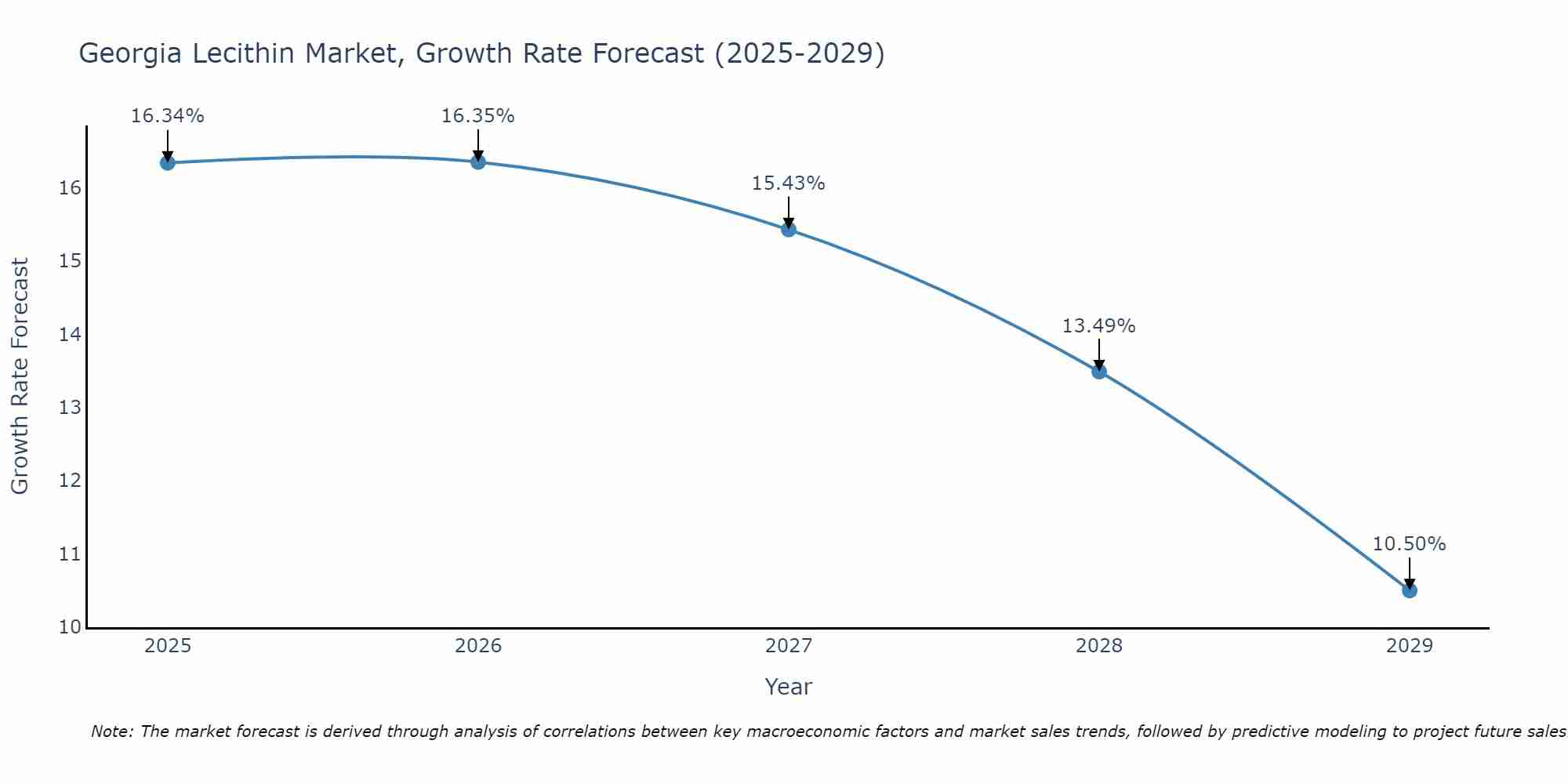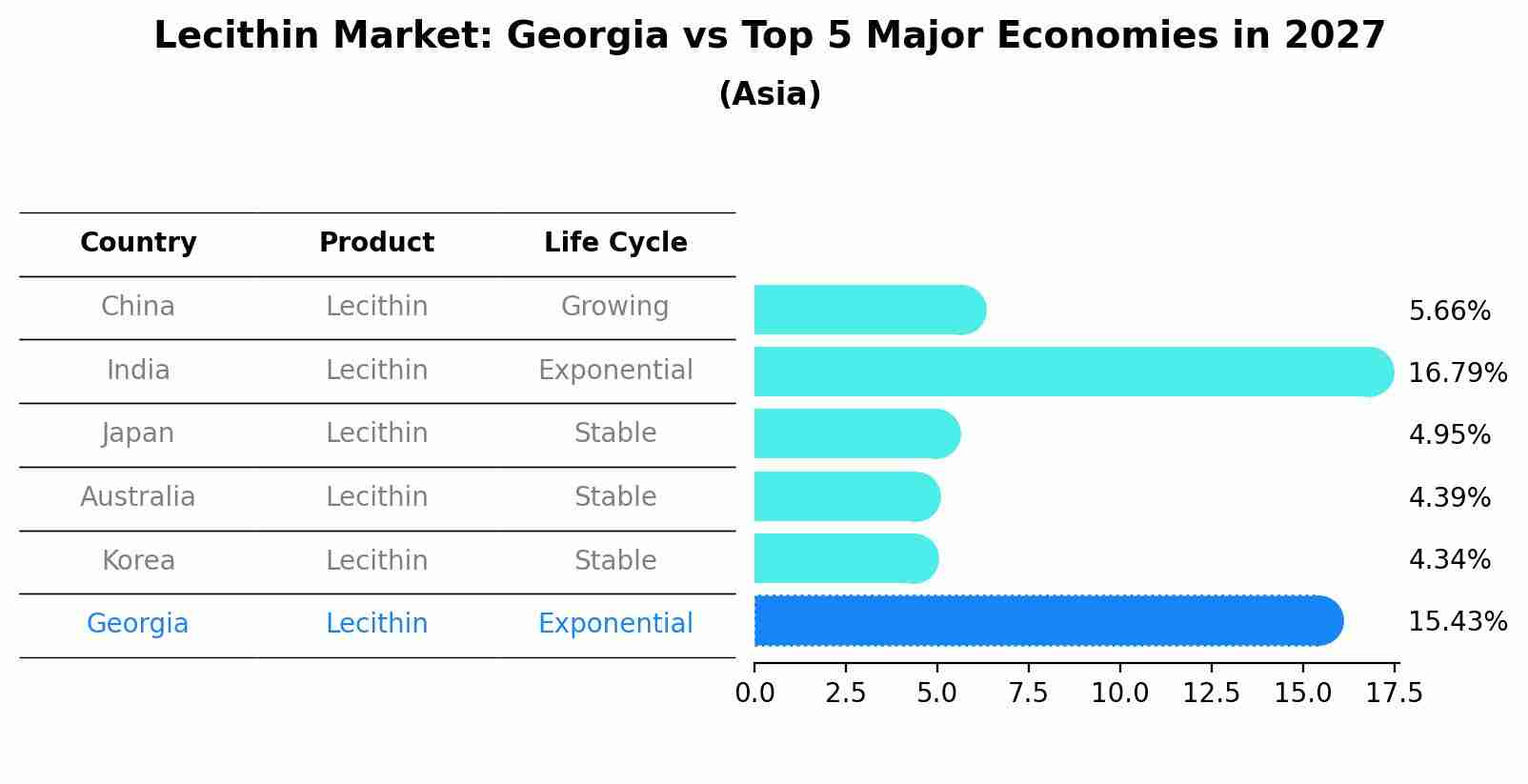Georgia Lecithin Market (2025-2031) Outlook | Trends, Share, Growth, Industry, Value, Revenue, Analysis, Forecast, Companies & Size
| Product Code: ETC417296 | Publication Date: Oct 2022 | Updated Date: Aug 2025 | Product Type: Market Research Report | |
| Publisher: 6Wresearch | Author: Ravi Bhandari | No. of Pages: 75 | No. of Figures: 35 | No. of Tables: 20 |
Georgia Lecithin Market Size Growth Rate
The Georgia Lecithin Market is projected to witness mixed growth rate patterns during 2025 to 2029. The growth rate begins at 16.34% in 2025, climbs to a high of 16.35% in 2026, and moderates to 10.50% by 2029.

Lecithin Market: Georgia vs Top 5 Major Economies in 2027 (Asia)
By 2027, the Lecithin market in Georgia is anticipated to reach a growth rate of 15.43%, as part of an increasingly competitive Asia region, where China remains at the forefront, supported by India, Japan, Australia and South Korea, driving innovations and market adoption across sectors.

Georgia Lecithin Market Overview
The Georgia lecithin market deals with the production and distribution of lecithin, a natural emulsifier commonly derived from soybeans or sunflower seeds. Lecithin finds applications in various industries, including food and beverage, pharmaceuticals, cosmetics, and animal feed. With its emulsifying, stabilizing, and moisturizing properties, lecithin is an essential ingredient in many products, driving the demand in this market.
Drivers of the market
The Georgia Lecithin market is driven by the growing awareness regarding the health benefits of lecithin and its wide-ranging applications across various industries such as food and beverage, pharmaceuticals, and cosmetics. Lecithin is valued for its emulsifying, stabilizing, and antioxidant properties, making it a vital ingredient in food formulations and industrial processes. The increasing demand for natural and organic ingredients, coupled with the rising prevalence of lifestyle diseases, fuels the adoption of lecithin-based products in Georgia. Moreover, the expanding food processing industry and the growing consumer inclination towards functional foods drive market growth.
Challenges of the market
Georgia lecithin market encounters challenges associated with production efficiency and market volatility. Maintaining consistent quality and supply of lecithin, a byproduct of soybean processing, requires efficient extraction and processing methods. Fluctuations in soybean prices and supply chain disruptions can affect the availability and affordability of lecithin products. Moreover, addressing concerns regarding allergen labeling and potential health risks associated with genetically modified soybeans presents regulatory challenges for market participants.
Government Policy of the market
Georgia government has enacted policies to encourage investment and innovation in the lecithin market, recognizing its diverse applications in food, pharmaceuticals, and industrial sectors. These policies aim to promote research and development, technology transfer, and quality standards compliance to enhance competitiveness and sustainability in lecithin production. Furthermore, the government collaborates with industry stakeholders to address challenges related to raw material sourcing, processing efficiency, and market access, facilitating growth and diversification in the lecithin market.
Key Highlights of the Report:
- Georgia Lecithin Market Outlook
- Market Size of Georgia Lecithin Market, 2024
- Forecast of Georgia Lecithin Market, 2031
- Historical Data and Forecast of Georgia Lecithin Revenues & Volume for the Period 2021-2031
- Georgia Lecithin Market Trend Evolution
- Georgia Lecithin Market Drivers and Challenges
- Georgia Lecithin Price Trends
- Georgia Lecithin Porter's Five Forces
- Georgia Lecithin Industry Life Cycle
- Historical Data and Forecast of Georgia Lecithin Market Revenues & Volume By Source for the Period 2021-2031
- Historical Data and Forecast of Georgia Lecithin Market Revenues & Volume By Soy for the Period 2021-2031
- Historical Data and Forecast of Georgia Lecithin Market Revenues & Volume By Sunflower for the Period 2021-2031
- Historical Data and Forecast of Georgia Lecithin Market Revenues & Volume By Rapeseed for the Period 2021-2031
- Historical Data and Forecast of Georgia Lecithin Market Revenues & Volume By Others for the Period 2021-2031
- Historical Data and Forecast of Georgia Lecithin Market Revenues & Volume By End-use for the Period 2021-2031
- Historical Data and Forecast of Georgia Lecithin Market Revenues & Volume By Convenience Food for the Period 2021-2031
- Historical Data and Forecast of Georgia Lecithin Market Revenues & Volume By Bakery for the Period 2021-2031
- Historical Data and Forecast of Georgia Lecithin Market Revenues & Volume By Confectionary for the Period 2021-2031
- Historical Data and Forecast of Georgia Lecithin Market Revenues & Volume By Pharmaceutical for the Period 2021-2031
- Historical Data and Forecast of Georgia Lecithin Market Revenues & Volume By Personal Care And Cosmetics for the Period 2021-2031
- Historical Data and Forecast of Georgia Lecithin Market Revenues & Volume By Animal Feed for the Period 2021-2031
- Historical Data and Forecast of Georgia Lecithin Market Revenues & Volume By Other Industrial for the Period 2021-2031
- Historical Data and Forecast of Georgia Lecithin Market Revenues & Volume By Form for the Period 2021-2031
- Historical Data and Forecast of Georgia Lecithin Market Revenues & Volume By Liquid for the Period 2021-2031
- Historical Data and Forecast of Georgia Lecithin Market Revenues & Volume By Powder for the Period 2021-2031
- Historical Data and Forecast of Georgia Lecithin Market Revenues & Volume By Granules for the Period 2021-2031
- Georgia Lecithin Import Export Trade Statistics
- Market Opportunity Assessment By Source
- Market Opportunity Assessment By End-use
- Market Opportunity Assessment By Form
- Georgia Lecithin Top Companies Market Share
- Georgia Lecithin Competitive Benchmarking By Technical and Operational Parameters
- Georgia Lecithin Company Profiles
- Georgia Lecithin Key Strategic Recommendations
Frequently Asked Questions About the Market Study (FAQs):
1 Executive Summary |
2 Introduction |
2.1 Key Highlights of the Report |
2.2 Report Description |
2.3 Market Scope & Segmentation |
2.4 Research Methodology |
2.5 Assumptions |
3 Georgia Lecithin Market Overview |
3.1 Georgia Country Macro Economic Indicators |
3.2 Georgia Lecithin Market Revenues & Volume, 2021 & 2031F |
3.3 Georgia Lecithin Market - Industry Life Cycle |
3.4 Georgia Lecithin Market - Porter's Five Forces |
3.5 Georgia Lecithin Market Revenues & Volume Share, By Source, 2021 & 2031F |
3.6 Georgia Lecithin Market Revenues & Volume Share, By End-use, 2021 & 2031F |
3.7 Georgia Lecithin Market Revenues & Volume Share, By Form, 2021 & 2031F |
4 Georgia Lecithin Market Dynamics |
4.1 Impact Analysis |
4.2 Market Drivers |
4.2.1 Growing consumer awareness about the health benefits of lecithin |
4.2.2 Increasing demand for natural and organic food ingredients |
4.2.3 Rising adoption of lecithin in various industries such as food, pharmaceuticals, and cosmetics |
4.3 Market Restraints |
4.3.1 Fluctuating prices of raw materials like soybeans affecting lecithin production costs |
4.3.2 Stringent government regulations regarding food additives and ingredient sourcing |
4.3.3 Competition from alternative emulsifiers and additives in the market |
5 Georgia Lecithin Market Trends |
6 Georgia Lecithin Market, By Types |
6.1 Georgia Lecithin Market, By Source |
6.1.1 Overview and Analysis |
6.1.2 Georgia Lecithin Market Revenues & Volume, By Source, 2021-2031F |
6.1.3 Georgia Lecithin Market Revenues & Volume, By Soy, 2021-2031F |
6.1.4 Georgia Lecithin Market Revenues & Volume, By Sunflower, 2021-2031F |
6.1.5 Georgia Lecithin Market Revenues & Volume, By Rapeseed, 2021-2031F |
6.1.6 Georgia Lecithin Market Revenues & Volume, By Others, 2021-2031F |
6.2 Georgia Lecithin Market, By End-use |
6.2.1 Overview and Analysis |
6.2.2 Georgia Lecithin Market Revenues & Volume, By Convenience Food, 2021-2031F |
6.2.3 Georgia Lecithin Market Revenues & Volume, By Bakery, 2021-2031F |
6.2.4 Georgia Lecithin Market Revenues & Volume, By Confectionary, 2021-2031F |
6.2.5 Georgia Lecithin Market Revenues & Volume, By Pharmaceutical, 2021-2031F |
6.2.6 Georgia Lecithin Market Revenues & Volume, By Personal Care And Cosmetics, 2021-2031F |
6.2.7 Georgia Lecithin Market Revenues & Volume, By Animal Feed, 2021-2031F |
6.3 Georgia Lecithin Market, By Form |
6.3.1 Overview and Analysis |
6.3.2 Georgia Lecithin Market Revenues & Volume, By Liquid, 2021-2031F |
6.3.3 Georgia Lecithin Market Revenues & Volume, By Powder, 2021-2031F |
6.3.4 Georgia Lecithin Market Revenues & Volume, By Granules, 2021-2031F |
7 Georgia Lecithin Market Import-Export Trade Statistics |
7.1 Georgia Lecithin Market Export to Major Countries |
7.2 Georgia Lecithin Market Imports from Major Countries |
8 Georgia Lecithin Market Key Performance Indicators |
8.1 Percentage increase in the adoption of lecithin in new product formulations |
8.2 Number of research studies highlighting the health benefits of lecithin |
8.3 Rate of expansion of lecithin applications in non-traditional industries such as nutraceuticals and animal feed |
9 Georgia Lecithin Market - Opportunity Assessment |
9.1 Georgia Lecithin Market Opportunity Assessment, By Source, 2021 & 2031F |
9.2 Georgia Lecithin Market Opportunity Assessment, By End-use, 2021 & 2031F |
9.3 Georgia Lecithin Market Opportunity Assessment, By Form, 2021 & 2031F |
10 Georgia Lecithin Market - Competitive Landscape |
10.1 Georgia Lecithin Market Revenue Share, By Companies, 2024 |
10.2 Georgia Lecithin Market Competitive Benchmarking, By Operating and Technical Parameters |
11 Company Profiles |
12 Recommendations |
13 Disclaimer |
- Single User License$ 1,995
- Department License$ 2,400
- Site License$ 3,120
- Global License$ 3,795
Search
Thought Leadership and Analyst Meet
Our Clients
Related Reports
- Canada Oil and Gas Market (2026-2032) | Share, Segmentation, Value, Industry, Trends, Forecast, Analysis, Size & Revenue, Growth, Competitive Landscape, Outlook, Companies
- Germany Breakfast Food Market (2026-2032) | Industry, Share, Growth, Size, Companies, Value, Analysis, Revenue, Trends, Forecast & Outlook
- Australia Briquette Market (2025-2031) | Growth, Size, Revenue, Forecast, Analysis, Trends, Value, Share, Industry & Companies
- Vietnam System Integrator Market (2025-2031) | Size, Companies, Analysis, Industry, Value, Forecast, Growth, Trends, Revenue & Share
- ASEAN and Thailand Brain Health Supplements Market (2025-2031) | Strategy, Consumer Insights, Analysis, Investment Trends, Opportunities, Growth, Size, Share, Industry, Revenue, Segments, Value, Segmentation, Supply, Forecast, Restraints, Outlook, Competition, Drivers, Trends, Demand, Pricing Analysis, Competitive, Strategic Insights, Companies, Challenges
- ASEAN Bearings Market (2025-2031) | Strategy, Consumer Insights, Analysis, Investment Trends, Opportunities, Growth, Size, Share, Industry, Revenue, Segments, Value, Segmentation, Supply, Forecast, Restraints, Outlook, Competition, Drivers, Trends, Demand, Pricing Analysis, Competitive, Strategic Insights, Companies, Challenges
- Europe Flooring Market (2025-2031) | Outlook, Share, Industry, Trends, Forecast, Companies, Revenue, Size, Analysis, Growth & Value
- Saudi Arabia Manlift Market (2025-2031) | Outlook, Size, Growth, Trends, Companies, Industry, Revenue, Value, Share, Forecast & Analysis
- Uganda Excavator, Crane, and Wheel Loaders Market (2025-2031) | Strategy, Consumer Insights, Analysis, Investment Trends, Opportunities, Growth, Size, Share, Industry, Revenue, Segments, Value, Segmentation, Supply, Forecast, Restraints, Outlook, Competition, Drivers, Trends, Demand, Pricing Analysis, Competitive, Strategic Insights, Companies, Challenges
- Rwanda Excavator, Crane, and Wheel Loaders Market (2025-2031) | Strategy, Consumer Insights, Analysis, Investment Trends, Opportunities, Growth, Size, Share, Industry, Revenue, Segments, Value, Segmentation, Supply, Forecast, Restraints, Outlook, Competition, Drivers, Trends, Demand, Pricing Analysis, Competitive, Strategic Insights, Companies, Challenges
Industry Events and Analyst Meet
Whitepaper
- Middle East & Africa Commercial Security Market Click here to view more.
- Middle East & Africa Fire Safety Systems & Equipment Market Click here to view more.
- GCC Drone Market Click here to view more.
- Middle East Lighting Fixture Market Click here to view more.
- GCC Physical & Perimeter Security Market Click here to view more.
6WResearch In News
- Doha a strategic location for EV manufacturing hub: IPA Qatar
- Demand for luxury TVs surging in the GCC, says Samsung
- Empowering Growth: The Thriving Journey of Bangladesh’s Cable Industry
- Demand for luxury TVs surging in the GCC, says Samsung
- Video call with a traditional healer? Once unthinkable, it’s now common in South Africa
- Intelligent Buildings To Smooth GCC’s Path To Net Zero


















